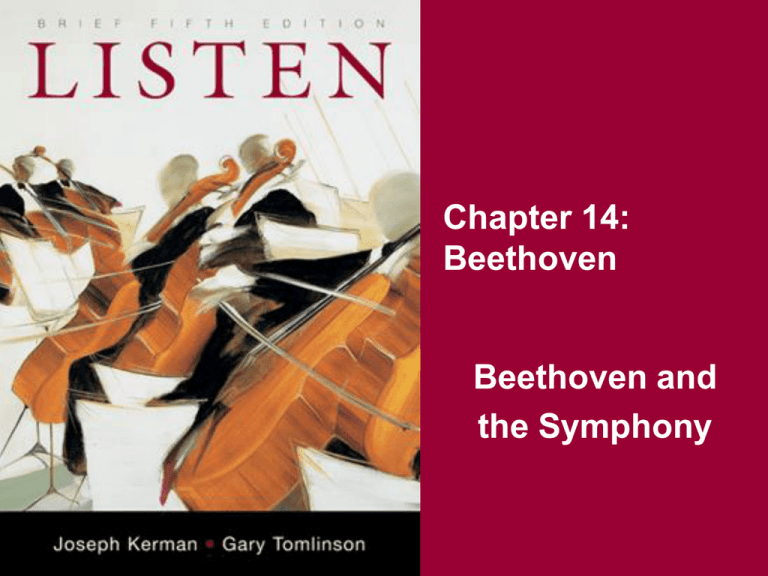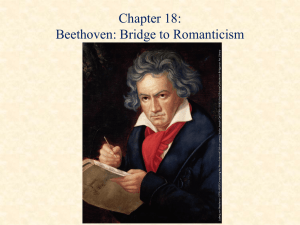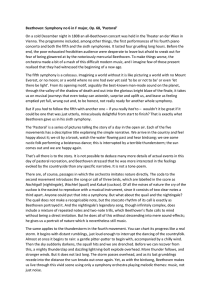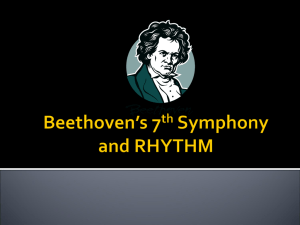Chapter 14: Beethoven Beethoven and the Symphony
advertisement

Chapter 14: Beethoven Beethoven and the Symphony Key Terms Rhythmic drive Motivic consistency Psychological progression Scherzo Fragmentation Rhythmic motive Ludwig van Beethoven (1) (1770-1827) Son & grandson of Bonn court musicians To Vienna in 1792 to study with Haydn Began a career as pianist & composer Progressive deafness diagnosed in 1802 • Beethoven considered suicide • Chose to devote his life to his art instead His music now took on a new urgency Forceful, strong-willed, uncompromising • He all but demanded support from nobility Ludwig van Beethoven (2) (1770-1827) Probably the 1st person to make a career solely from composing • Seen as a genius, he seemed to live for his art • Many affairs, but he never married Totally deaf by 1820 Adopted his orphan nephew in later years • Beethoven was much too overprotective • Shock of his nephew’s suicide attempt hastened his own death 20,000 attended Beethoven’s funeral Beethoven and the Symphony (1) Beethoven created excitement & urgency by maximizing musical elements • Higher and lower registers • Sharper syncopations & stronger accents • Harsher dissonances that must struggle to arrive at yet more profound resolutions • New demands on instruments • Expansion of the orchestra • Classical forms stretched to their limits Beethoven and the Symphony (2) Beethoven wrote only nine symphonies • He wrote many more piano sonatas (32) & string quartets (16) But Beethoven is associated especially with the symphony • Wrote some of the greatest symphonies ever • Orchestra provided the greatest range of expression, variety, & sheer volume • Even his sonatas & quartets of 1800-1810 sound like symphonies – and require new techniques of piano & string playing! Beethoven and the Symphony (3) Beethoven’s “symphonic ideal” can be observed in his Fifth Symphony (1808) Three main features have impressed generations of listeners • Rhythmic drive • Motivic consistency • Psychological progression Rhythmic Drive Blunt, even ferocious rhythms produce a palpable physical impact Beethoven hammers the meter • Emphasizes meter & disrupts it with equal vigor • Piles accent upon accent, rhythm upon rhythm • Rhythmic motives surge forward Long-range rhythmic planning & goals A far cry from the elegance & wit of Classical style Motivic Consistency Constant repetition of a single motive • Especially in 1st movement of Symphony 5 Motive repeated, yet constantly varied Variations never sound random • Motive becomes more significant & vivid as work progresses • Creates a feeling of organic growth – like a plant’s leaves growing from a single seed Psychological Progression Symphony no longer simply 4 contrasting movements Beethoven now traces a coherent & dramatic psychological progression “There fate knocks at the door!” • Beethoven on the 1st movement • But Fate is trampled under by a military march in the the last movement Symphony now expresses an inspirational life process – a drama to rival opera! The Scherzo Beethoven substitutes a scherzo for the traditional minuet Italian word scherzo = joke Aristocratic minuet too formal Scherzo shares a few features with minuet • A B A form & triple meter But scherzo was much faster • Rhythmic drive & frequent syncopation give it a brusque, jocular, even violent feel Beethoven, Symphony No. 5, I (1) Motivic consistency prominent here A single rhythmic motive dominates • • • • It forms the first theme It initiates the bridge It appears as background to lyrical 2nd theme It emerges again in the cadence material Beethoven, Symphony No. 5, I (2) • It is used throughout the development • It continues to grow in the long coda Motive gives the work a gripping urgency Beethoven, Symphony No. 5, I (3) Listen for— • Arresting, primal first statement of Theme 1 motives separated by fermatas • Horn-call bridge announces Theme 2 • Theme 1 variant announces the development • Thematic fragmentation in the development • Oboe cadenza in the recapitulation • Recapitulation’s 2nd group in major key • LONG, developmental coda with new theme • Main motive repeated & varied in every bar! The Remaining Movements First movement ends with a standoff at the end of a heroic struggle Later movements respond to and resolve this struggle The rhythmic motive recurs in each movement to remind us of the struggle C minor passages also recall the struggle C major passages point to the ultimate triumph over Fate Beethoven, Symphony No. 5, II Double theme & variations form • Six variations on Theme 1 Primary key is A-flat major • Modulates to C major 3 times for powerful, triumphant fanfare passages • Rhythmic motive appears in mysterious retransition to A-flat Beethoven, Symphony No. 5, III (1) Scherzo movement in A B A form A section recalls 1st movement • Spooky a theme is in C minor with fermata interruptions • Rhythmic motive dominates forceful b theme Beethoven, Symphony No. 5, III (2) B section (Trio) points to Fate’s defeat • Humorous fugal section in C major Return of A completely transformed • Mysterious pizzicato & oboe • Leads into doubly mysterious transition Beethoven, Symphony No. 5, IV (1) Eerie transition leads directly into IV • Rhythmic motive in timpani • Music grows gradually louder & clearer • At climax, full orchestra (with trombones) announces marchlike 1st theme of the 4th movement – in C major Straightforward sonata form movement • Theme 2 based on the rhythmic motive Beethoven, Symphony No. 5, IV (2) End of development brings back 3rd movement’s b theme & eerie transition • A final reminder of the struggle Recapitulation & coda provide a great Cmajor celebration • No surprises in recapitulation • LONG coda in three sections revisits previous themes • Final section accelerates tempo for a rousing Presto finale • Ending drives home C major chord Conclusions The dramatic strength & rhythmic power of this work went far beyond earlier music Beethoven unified the symphony • Motives appear in more than one movement • Movements can be connected without pause • The symphony narrates a dramatic “story” Beethoven single-handedly changed the nature of the symphony genre • Never again would the symphony be a simple entertainment




